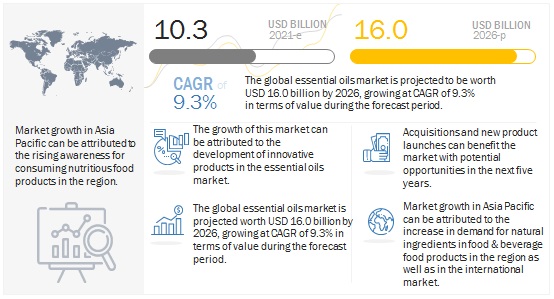The Essential Oils Market size is estimated to be valued USD 10.3 billion in 2021 and is expected to reach a value of USD 16.0 billion by 2026, growing at a CAGR of 9.3% in terms of value during the forecast period. In terms of volume, the essential oils market is estimated to account for 253.2 KT in 2021 and is expected to reach at 345.4 KT by 2026, growing at a CAGR of 6.4% during the forecast period.
Factors such as an growth in awareness toward preventive healthcare, rise in demand for essential oils in food products with extended shelf life , along with increase in demand for essential oils in cosmetic applications are some of the factors driving to the growth of the essential oils market.
Opportunity: Rise in demand for natural ingredients
The demand for “all-natural ingredients” has lately been on the rise mainly due to the growing awareness about the benefits of natural ingredients and the increasing disposable income, which results in people spending more money on expensive natural products. The increasing health consciousness among people fuels this demand further by leading to more liberal spending on good-quality natural products, which would provide long-lasting results.

Several manufacturers across all industries are developing new ways of incorporating natural and healthy ingredients in their formulations for providing maximum benefits to the consumers. ‘Natural claims’ largely influence the purchase of food & beverage and cosmetic applications. Essential oils provide that ‘all natural’ flavor and fragrance across several industries such as food & beverage, cosmetics, feed, and home care, among others, which creates several opportunities for essential oils market.
Challenges : Prevalence of synthetic/adulterated products
There is an important concern of adulteration in essential oils, which has become a major challenge for essential oils market. Not all essential oils are created equal and may contain synthetic adulterants. These adulterated essential oils do not possess the properties of essential oils and merely act as fragrance products.
Adulterated essential oils are extremely hazardous. They may have numerous side effects and may cause permanent damage to the organs. However, the high prices of essential oils are the main reason for the prevalence of such adulterated and synthetic products. One liter of pure rose essential oil costs around USD 78 thousand; however, the inferior quality of the same quantity would cost around 200–300 dollars. Adulteration thus helps in cutting down the cost and making the product available for the masses, owing to which there is a prevalence of synthetic/adulterated products.
Key players in this market include Cargill, Inc. (US), DuPont (US), Koninklijke DSM N.V. (Netherlands), dôTERRA International LLC (US), Givaudan SA (Switzerland), Firmenich SA (Switzerland), Young Living Essential Oils (US), Sensient Technologies Corporation (US), The Lebermuth Company, Inc. (US), International Flavors & Fragrances Inc. (US), Symrise (Germany), MANE (France), ROBERTET SA (France), Rocky Mountain Oils LLC (US), BIOLANDES SAS (France), Essential Oils of New Zealand (New Zealand), Falcon (India), Farotti (Italy), India Essential Oils (India), and Ungerer Limited (UK).